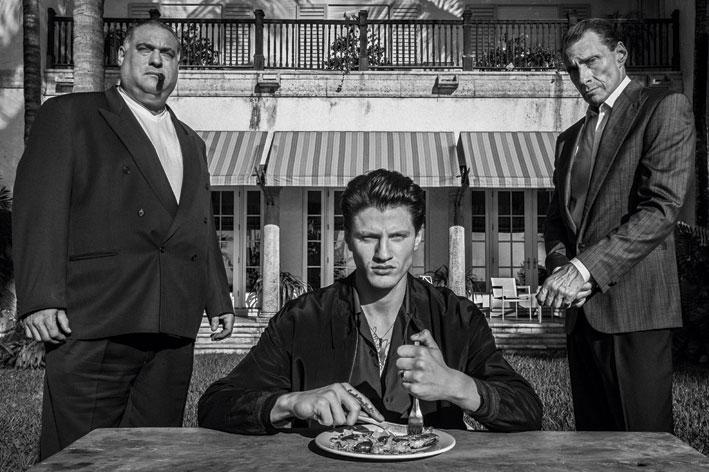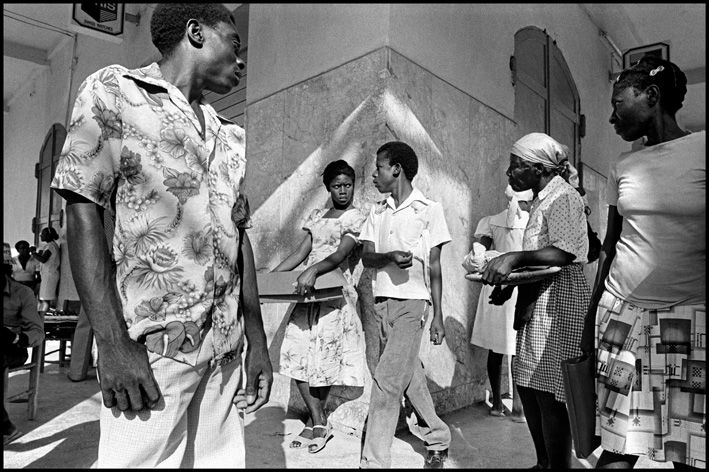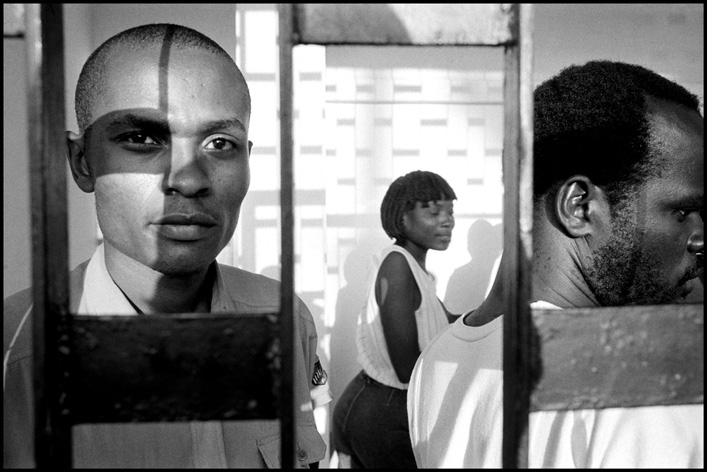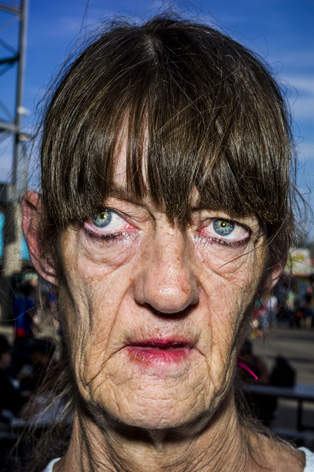Magnum photographer Bruce Gilden opens up his archive of ’characters’

If Paul Giamatti has been dubbed our time's character actor, then Bruce Gilden must be our character photographer. Having grown up on the mean streets of Brooklyn in the 1960s, Gilden began his career snapping the larger-than-life 'characters' of his urban surroundings, from Coney Island's lobstered sunbathers to his local neighborhood tough guys.
Attracted to the darker side of life, with an avid interest in the often harsh realities of the average man, the former sociology student soon became known for his extreme up-close, reportage style. Shooting his subjects on-the-go, with most still lost in thought at the moment his flash fires, Gilden's in-motion technique allows him to capture both the energy, and anxiety of their startled gazes on film.
Putting the viewer at the centre of his subject's story through his tight composition, Gilden's artistic ambush delivers a voyeuristic intimacy that has seen him colourfully document far-flung cultures – from the many faces of Haiti (he's been there 22 times since his first visit in 1984), to his world-weary portraits of Portugal's gypsy community.
And although America remains his preferred hunting ground, the homogenisation of cities like his beloved New York has lead him abroad in recent years, releasing books such as 'After the Off', capturing the 'riveting strangeness' of Irish horse racing, and 'Go', examining Japan's shadier sub-cultures from the Yakuza (mobsters) to the Bōsōzoku motorcycle gang.
Favouring age over youth, and black and white over colour, the Magnum photographer may be not be the obvious choice to shoot a fashion story in the Miami tropics for our March Issue (W*180), but Gilden nethertheless indulged us, albeit with a few wise guys thrown in for good measure.
However, gangsters aside, as it turns out, these days the 67 year-old is just as obsessed with his cats as he is with chronies. And contrary to the serious nature of much of his work, the man also loves a good laugh, reflective of the archive selection that he shares with us here, capturing truth, humour, pain and compassion in his art – just like you'd expect from any real character.
We speak to the photographer (pictured below) about his street style and our March issue's Al Capone connection…

W*: You're the antithesis of the photo-lens photographer who spies on their subjects from afar, and have said that as you get older, you're only getting closer… so what are you looking for in your 'characters'?
Bruce Gilden: I think the closer you are to the subject, the closer you can get to their soul.
What is it about the street that's always charged your creativity?
I was able to go out, use my athleticism, not speak to anybody and lose myself in the crowded streets.
You've said: 'What makes a good photographer is that you photograph who you are…' So who are you, looking at the images you have chosen for us?
When I was five years old I wanted a monkey, to play the drums and be a boxer. Even at that age, I always liked underdogs and people who aren't your average person.
Explain the thrill of getting the shot?
If you don't feel it, you can't shoot it. It's intuitive. When you see something that makes you want to raise your camera to your eye, it's a good feeling.
Starting in the boroughs of Brooklyn you soon moved off shore in search of conventional cultural clichés to subvert…. Where would you still like to venture?
South Africa or somewhere where there are tough guys.
We've heard that you can't stand your Brooklyn accent…?
I always wanted to do Shakespeare but I always knew it would be difficult for me.
What interested you about shooting for Wallpaper*?
It's classy.
You shot at Al Capone's former Florida home. Tell us about the casting for the fashion story?
The casting for the Wallpaper* shoot was quite important because, as in my personal work, I needed people who stimulated me visually in order to make good photos. Once we have these people in place, the next part of the process comes into play: where to place them and doing what. With the right people, it flows much more smoothly.
You shot in Miami, yet the story is all in black and white…?
For my whole photographic life until approximately two years ago, I shot in black and white. Now I'm working mostly in colour. Some subjects are better in black and white and others speak to me in colour.
In this instance you shot digital. What medium do you prefer?
I prefer film, however digital has advantages. It spoils you: you see the end product right away. It's like a narcotic. And you don't have to worry about your film getting X-rayed at the airport.
After launching your latest book 'A Complete Examination of Middlesex' late last year, what's next for you?
I received a Guggenheim Fellowship this year and I'm working on a project called 'Left Behind', which consists mostly of peoples' faces in colour. Most of it is shot in America and some is in the English Midlands.

'Woman on beach pointing at a man...' by Bruce Gilden, 1982, Coney Island, New York

'Untiltled' by Bruce Gilden, 1984, New York City

'Untiltled' by Bruce Gilden, 1984, New York City

'Untiltled' by Bruce Gilden, 1985, Port-au-Prince, Haiti

'Untiltled' by Bruce Gilden, 1986, New York City

'A family walks along the crowded...' by Bruce Gilden, 1988, Coney Island, New York

'Cemetery' by Bruce Gilden, 1988, Port-au-Prince, Haiti

'Man, dog, cart' by Bruce Gilden, 1989, New York City

'Soccar stadium...early evening' by Bruce Gilden, 1990, Port-au-Prince, Haiti

'Woman walking on Fifth Avenue' by Bruce Gilden, 1992, New York

'Untitled' by Bruce Gilden, 2010, Fresno, California

'Near the bus station on rue Dessalines...' by Bruce Gilden, 2011, Port-au-Prince, Haiti

'Satellite dish in front' by Bruce Gilden, 2011 Las Vegas, Nevada

'Untitled' by Bruce Gilden, 2012, London

'Untitled' by Bruce Gilden, 2012, London

'Colleen at the state fair' by Bruce Gilden, 2013, Milwaukee, Wisconsin

'Mary at the state fair' by Bruce Gilden, 2013, Milwaukee, Wisconsin

'Jean at the state fair' by Bruce Gilden, 2013, Milwaukee, Wisconsin

'Ann at the state fair' by Bruce Gilden, 2013, Milwaukee, Wisconsin
Wallpaper* Newsletter
Receive our daily digest of inspiration, escapism and design stories from around the world direct to your inbox.
-
 All-In is the Paris-based label making full-force fashion for main character dressing
All-In is the Paris-based label making full-force fashion for main character dressingPart of our monthly Uprising series, Wallpaper* meets Benjamin Barron and Bror August Vestbø of All-In, the LVMH Prize-nominated label which bases its collections on a riotous cast of characters – real and imagined
By Orla Brennan
-
 Maserati joins forces with Giorgetti for a turbo-charged relationship
Maserati joins forces with Giorgetti for a turbo-charged relationshipAnnouncing their marriage during Milan Design Week, the brands unveiled a collection, a car and a long term commitment
By Hugo Macdonald
-
 Through an innovative new training program, Poltrona Frau aims to safeguard Italian craft
Through an innovative new training program, Poltrona Frau aims to safeguard Italian craftThe heritage furniture manufacturer is training a new generation of leather artisans
By Cristina Kiran Piotti
-
 ‘People are really in their element’: Martin Parr on capturing bar culture, and his look back with Campari
‘People are really in their element’: Martin Parr on capturing bar culture, and his look back with CampariMagnum Photos and Campari join forces for ‘Bar Stories on Camera’, currently on view in Turin, including works by Martin Parr
By Amah-Rose Abrams
-
 New Magnum Square Print Sale: what to buy, from Roger Deakins to Alfredo Jaar
New Magnum Square Print Sale: what to buy, from Roger Deakins to Alfredo JaarThe new Magnum Square Print Sale (17–23 April 2023) looks beyond the agency’s roster for the first time, inviting artists, filmmakers, and fellow photographers to join alongside Magnum Photographers
By Harriet Lloyd-Smith
-
 Magnum Photos launches new Square Print Sale
Magnum Photos launches new Square Print SaleTitled ‘Now’, the latest Magnum Photos print sale (until 23 October 2022) features work from 31 photographers, curated with The Photographers’ Gallery, London
By Sophie Gladstone
-
 Olivia Arthur on expanding photography and minimising preconceptions
Olivia Arthur on expanding photography and minimising preconceptions‘Through the lens’ is our monthly series that spotlights photographers who are Wallpaper* contributors. Here we explore the vision of Magnum photographer Olivia Arthur
By Sophie Gladstone
-
 Sensuality and strength: Olivia Arthur photographs Saint Laurent for new exhibition
Sensuality and strength: Olivia Arthur photographs Saint Laurent for new exhibitionOlivia Arthur is one of six photographers taking part in the latest chapter of Saint Laurent’s ‘Self’ project – this time, an exhibition in collaboration with Magnum Photos. Here, she tells Wallpaper* more
By Jack Moss
-
 Magnum Photos’ new Paris gallery spotlights past and future
Magnum Photos’ new Paris gallery spotlights past and futureMagnum Photos expands its footprint with a new gallery space in Paris, inaugurated with multigenerational joint show ‘Bruce Davidson & Khalik Allah: New York’
By Amy Serafin
-
 Magnum photographer Olivia Arthur on ‘culture, people and machines’
Magnum photographer Olivia Arthur on ‘culture, people and machines’The Photography Show 2021 at the NEC Birmingham hosts a discussion forum where visual talent views the world via the prism of humanity and technology, imagination and reality
By Simon Mills
-
 Magnum photographers on finding escape in image-making
Magnum photographers on finding escape in image-makingAvailable at $100 each until 18 July 2021, Magnum Photos square print sale captures different ways to find escapism, break free or make a getaway
By Harriet Lloyd-Smith